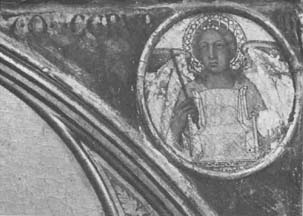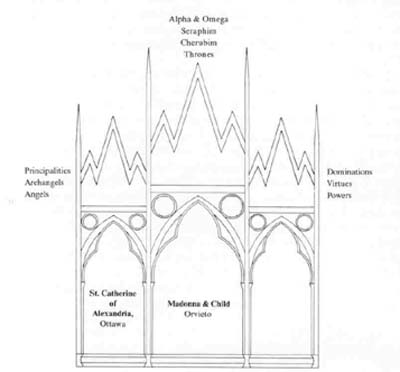
Annual Bulletin 3, 1979-1980
Home
Français
Introduction
History
Annual Index
Author &
Subject
Credits
Contact



Simone
Martini's St Catherine of Alexandria:
An Orvietan Altarpiece and the
Mystical Theology of St Bonaventure
by Joel Brink
Pages 1
| 2
| 3 | 4
| 5
| 6
| 7
| 8
According to Dionysius and such scholastics as St Thomas Aquinas
and St Bonaventure (the Dominican and Franciscan theologians who borrowed
extensively from De Coelesti Hierarchia, (19) the Seraphim were considered
to be closest to God and hence on fire with love of the Father, whereas
the Cherubim were characterized by their unsurpassed knowledge of God and signified divine wisdom. The Thrones were distinguished by their
knowledge of the meanings of God's works in the Father himself and thus
were often representative of divine justice. These points of significance
match closely the attributes given the angels in the Orvietan painting.
The Seraph (fig. 13) with its luminous wings and warm colorful drapery
turns to behold God directly and in its hands holds the burning candles
which symbolize the intensity of its love of the Father. The Cherub (fig.
14) is depicted with three pairs of wings, though less luminous, and a
cool-blue vestment. In its hands the Cherub displays an open book with
text, which, along with the laurel crown, signifies fullness of knowledge.
Although the carefully inscribed text in the open book might appear at
first to be an actual Latin passage, on close analysis the text has no
rational sense whatsoever. Aside from the fact that the passage may not
have been legible from below nor intended to reproduce a specific literary
tract, the fact that it defies linguistic analysis (and may in fact be
a kind of riddle) would fit with the idea of the Dionysius: the Cherubim
could not communicate their illuminations directly to the corporeal realm,
but only to the intermediate order of the angelic hierarchy which in turn
would transmit them below. (20) Finally, the Thrones (figs 15 & 16)
which comprise the lowest level of the upper triad are set off from the
Seraph and Cherub by having two pairs of wings, and they hold staffs and
orbs to denote their judicial power. The draped, open thrones they display before them could allude to the
description of the Dionysius in
which he compares the order to the properties of a chair: its elevated
position, strength, support, and open shape - qualities which, according
to the author, bring the Thrones into close proximity to God the Father. (21)
The lower two orders of the angelic hierarchy are also described
in detail in De Coelesti Hierarchia, and we can be certain that
the original Orvietan altarpiece included these angels in the lost roundels
and pinnacles of the side panels. Such systems of angelic choirs were known
elsewhere in the visual arts; we find, for example, in the vault of the Florentine Baptistery (where Dante and Simone could have seen them) the
complete celestial hierarchy radiating out from the Redeemer, the Alpha
and Omega - and other similar cycles are found in San Marco, Venice,
and in the Baptistery of Padua Cathedral. (22) However, whereas the Florentine
mosaics present a comprehensive view of the whole history of salvation,
the iconography of the Orvietan altarpiece - which unites the teaching
Christ and the scripture from the Gospel of St John with the angelic
hierarchy and the Redeemer - is more specifically rooted in mystical theology
of the Franciscans.
In the process of a review of the spiritual works of St Bonaventure
(fig. 18), the supreme theologian of the Franciscan Order and its Minister
General between 1257 and 1273, it became evident that the unusual iconographical
program of the altarpiece could be elucidated by the Seraphic Doctor's
mystical sermons.(23) To the Franciscan intimately acquainted with the mystical
opuscula of St Bonaventure (and we can be certain that many in
the Trecento were), the
appearance in the painting of a teaching Christ with three-fold text, together
with the angelic hierarchy and the Redeemer, would have provided the essential
elements constituting a particular mode of contemplation involving the
divinity of Christ. This mystical process led upward systematically from
the hierarchal interpretation of scripture to the preparation of the
soul and its ultimate union with Cod. Influenced by the mystical doctrines
of Dionysius, St Bonaventure perceived three-fold analogical patterns
extending from the divinely inspired scripture to the angelic choirs and
to the Trinity. Rising from the divinely-engineered three-fold revelation
of scripture and spiritual acts of purgation, illumination, and
perfection,
the soul of the contemplative (according to St Bonaventure's
mystical sermons) entered the celestial sphere where it was marked with
nine levels corresponding symbolically to the nine choirs of angels. The
goal of the ascent was represented by blissful union with Cod in the upper-celestial
realm where the three persons of the Trinity were revealed in the mind's
eye of the contemplative. (24)
In the painting, the image of the teaching Christ shown pointing
to the text on his scroll was probably inspired by St Bonaventure's celebrated
sermon entitled Christus unus omnium magister (Christ, the One
Teacher of All). (25) The sermon is especially appropriate because its
three-fold form and content was based on the Same scripture that the Christ-child admonishes us to behold in the painting: "I am the Way, the Truth
and the Life." According to St Bonaventure, Christ is the Way because
he is the master of faith; he is the Truth because he is the master
of rational knowledge; and he is the Life because he is the master of the knowledge of contemplation. With Christ as the Teacher it is
thus possible to progress from the stability of faith to the serenity of
reason and ultimately to attain the sweetness of contemplation. St Bonaventure
emphasizes two modes of contemplation in his sermon, namely a going-in and a going-out. "The going-in is to go to Christ as the uncreated
Word and the food of angels," to use St Bonaventure's words, and the going-out
is to go to Christ as the incarnate Word. While the first is concerned
with his divinity, the second involves his humanity. To elaborate
on the first mode of contemplation St Bonaventure quotes from the Psalm:
"I will go in to the place of the wonderful tabernacle up to the dwelling
place of God...." "This refers, " he says, "to the heavenly Jerusalem.
No one can enter into the contemplation of it unless he is led in through
the uncreated Word which is Christ. Therefore, Dionysius writes in the
first book of De Coelesti Hierarchia (I, 1-2), 'In as far as possible,
we look to the illumination of the most sacred words given by the Father.
In as far as we are able, we will consider the hierarchies of the heavenly
spirits manifest in them for us symbolically and anagogically....' "
Next Page | divinity
of Christ and angelic hierarchies
1
| 2
| 3 | 4
| 5
| 6
| 7
| 8
Annual Index | Author & Subject | Credits | Contact
This digital collection
was produced under contract to Canada's Digital Collections program,
Industry Canada.
"Digital
Collections Program, Copyright
© National Gallery of
Canada 2001"